Analyzing Innovation & New Technologies for Incumbent Firms
VerifiedAdded on 2023/06/09
|13
|3180
|375
Essay
AI Summary
This essay examines the challenges faced by incumbent firms due to technological disruptions and the rise of market challengers. It discusses how technological discontinuities can drive transitions in the industrial sector, forcing incumbents to adapt their business models. The paper explores defensive strategies that incumbents can employ to protect their market share and influence challengers' expectations. It also identifies innovation inhibitors, such as organizational structures and reliance on past successes, that can hinder incumbents' ability to respond to new technologies. Furthermore, the essay highlights the implications of rapidly developing economy-based organizations as challengers and emphasizes the need for incumbents to overcome their limitations and embrace innovation to remain competitive. Desklib offers a variety of resources, including past papers and solved assignments, to aid students in understanding these complex business dynamics.
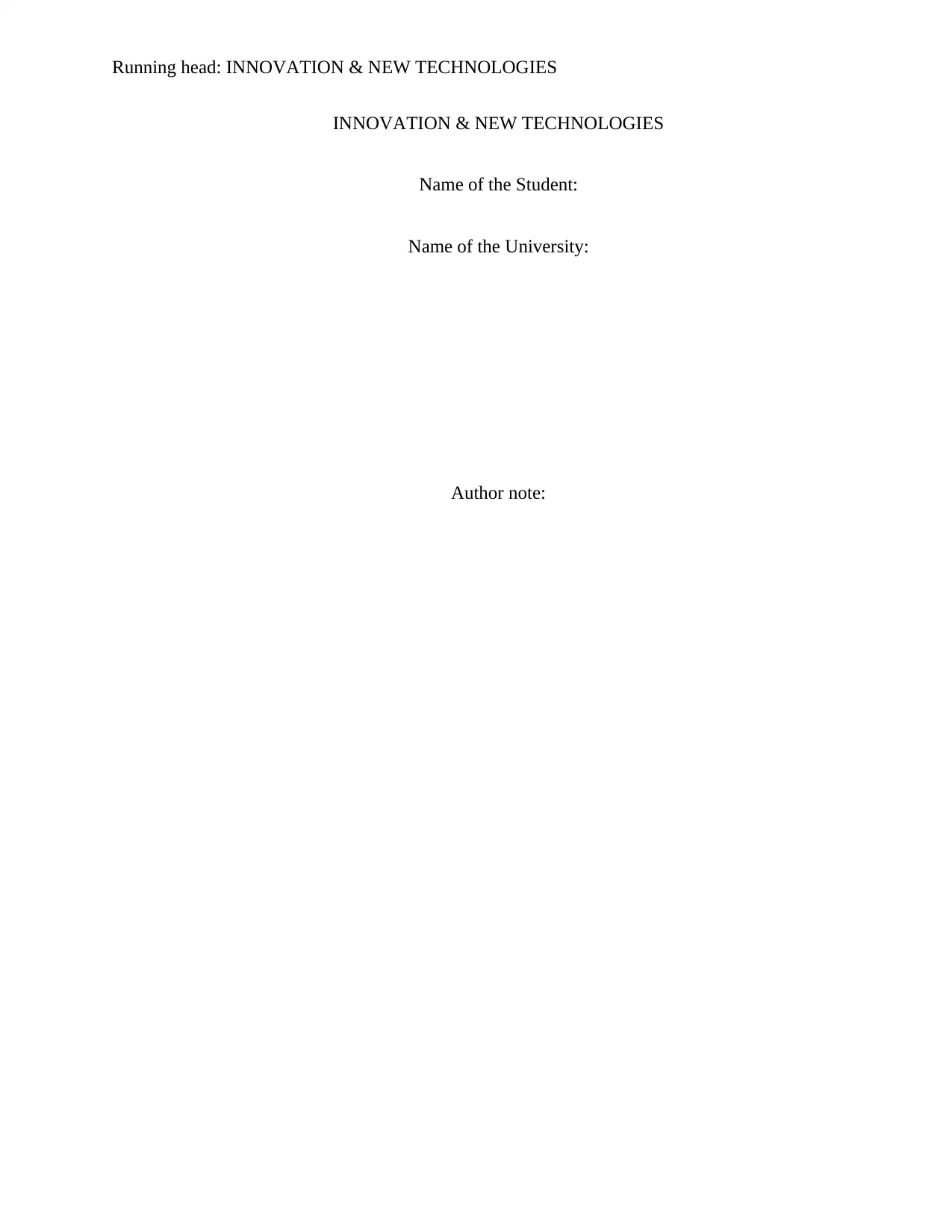
Running head: INNOVATION & NEW TECHNOLOGIES
INNOVATION & NEW TECHNOLOGIES
Name of the Student:
Name of the University:
Author note:
INNOVATION & NEW TECHNOLOGIES
Name of the Student:
Name of the University:
Author note:
Paraphrase This Document
Need a fresh take? Get an instant paraphrase of this document with our AI Paraphraser
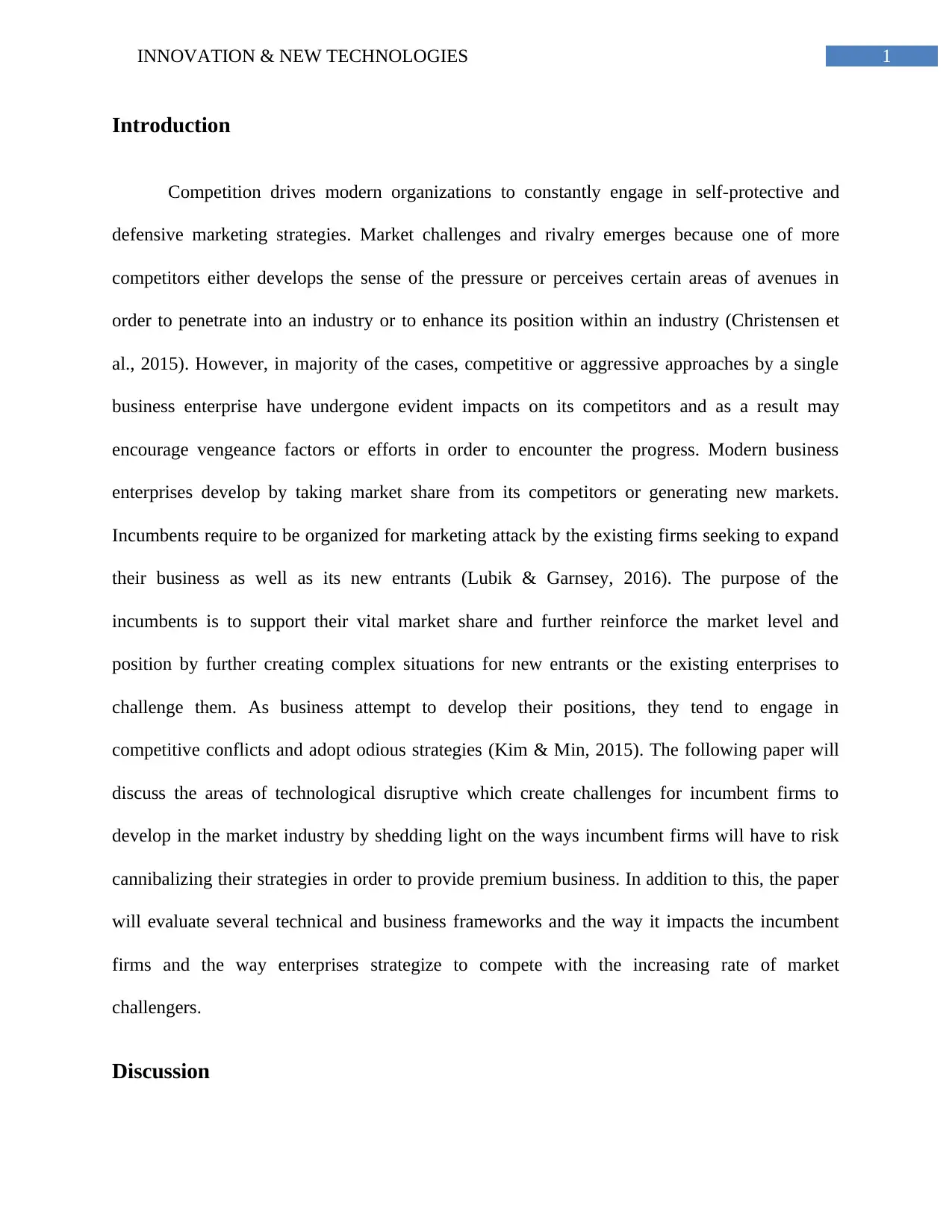
1INNOVATION & NEW TECHNOLOGIES
Introduction
Competition drives modern organizations to constantly engage in self-protective and
defensive marketing strategies. Market challenges and rivalry emerges because one of more
competitors either develops the sense of the pressure or perceives certain areas of avenues in
order to penetrate into an industry or to enhance its position within an industry (Christensen et
al., 2015). However, in majority of the cases, competitive or aggressive approaches by a single
business enterprise have undergone evident impacts on its competitors and as a result may
encourage vengeance factors or efforts in order to encounter the progress. Modern business
enterprises develop by taking market share from its competitors or generating new markets.
Incumbents require to be organized for marketing attack by the existing firms seeking to expand
their business as well as its new entrants (Lubik & Garnsey, 2016). The purpose of the
incumbents is to support their vital market share and further reinforce the market level and
position by further creating complex situations for new entrants or the existing enterprises to
challenge them. As business attempt to develop their positions, they tend to engage in
competitive conflicts and adopt odious strategies (Kim & Min, 2015). The following paper will
discuss the areas of technological disruptive which create challenges for incumbent firms to
develop in the market industry by shedding light on the ways incumbent firms will have to risk
cannibalizing their strategies in order to provide premium business. In addition to this, the paper
will evaluate several technical and business frameworks and the way it impacts the incumbent
firms and the way enterprises strategize to compete with the increasing rate of market
challengers.
Discussion
Introduction
Competition drives modern organizations to constantly engage in self-protective and
defensive marketing strategies. Market challenges and rivalry emerges because one of more
competitors either develops the sense of the pressure or perceives certain areas of avenues in
order to penetrate into an industry or to enhance its position within an industry (Christensen et
al., 2015). However, in majority of the cases, competitive or aggressive approaches by a single
business enterprise have undergone evident impacts on its competitors and as a result may
encourage vengeance factors or efforts in order to encounter the progress. Modern business
enterprises develop by taking market share from its competitors or generating new markets.
Incumbents require to be organized for marketing attack by the existing firms seeking to expand
their business as well as its new entrants (Lubik & Garnsey, 2016). The purpose of the
incumbents is to support their vital market share and further reinforce the market level and
position by further creating complex situations for new entrants or the existing enterprises to
challenge them. As business attempt to develop their positions, they tend to engage in
competitive conflicts and adopt odious strategies (Kim & Min, 2015). The following paper will
discuss the areas of technological disruptive which create challenges for incumbent firms to
develop in the market industry by shedding light on the ways incumbent firms will have to risk
cannibalizing their strategies in order to provide premium business. In addition to this, the paper
will evaluate several technical and business frameworks and the way it impacts the incumbent
firms and the way enterprises strategize to compete with the increasing rate of market
challengers.
Discussion
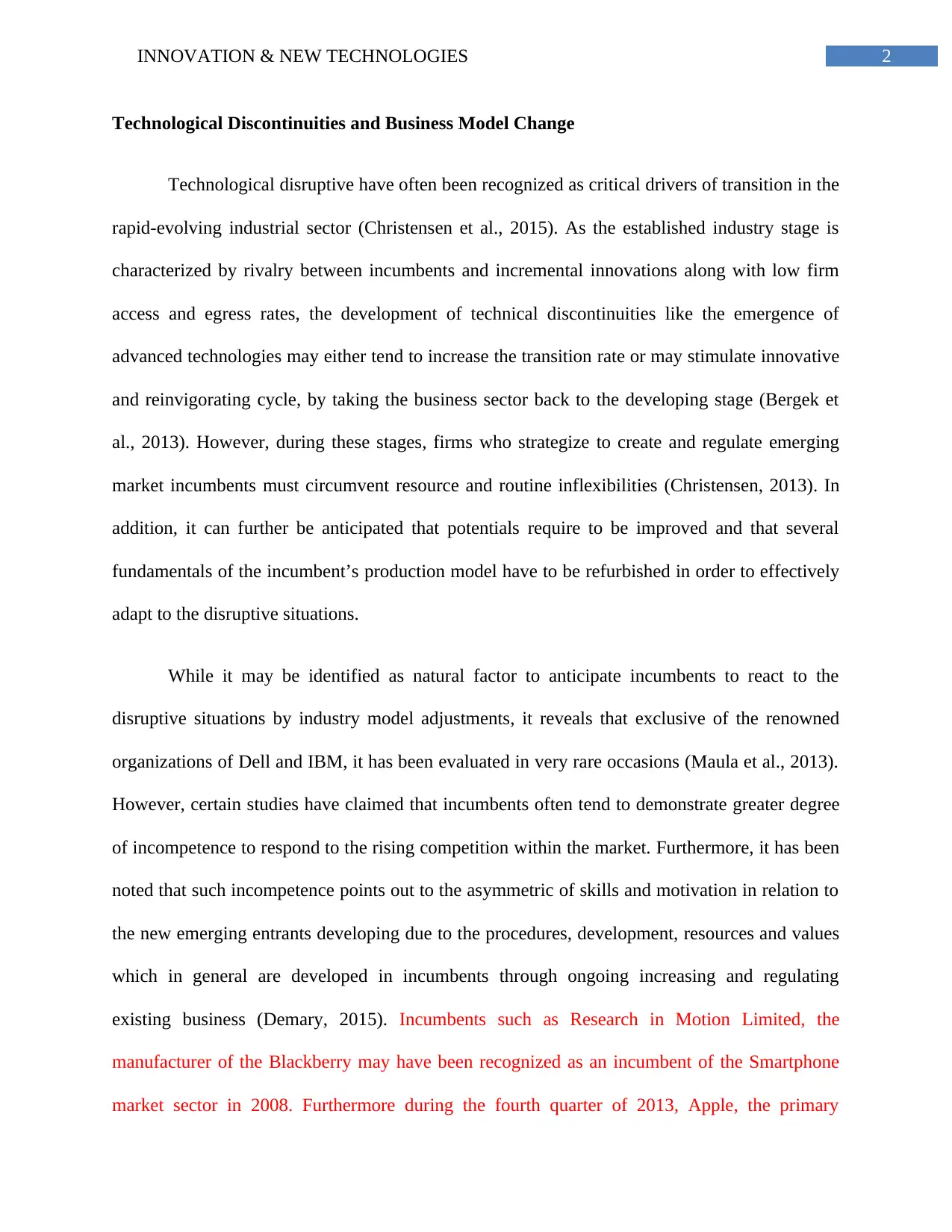
2INNOVATION & NEW TECHNOLOGIES
Technological Discontinuities and Business Model Change
Technological disruptive have often been recognized as critical drivers of transition in the
rapid-evolving industrial sector (Christensen et al., 2015). As the established industry stage is
characterized by rivalry between incumbents and incremental innovations along with low firm
access and egress rates, the development of technical discontinuities like the emergence of
advanced technologies may either tend to increase the transition rate or may stimulate innovative
and reinvigorating cycle, by taking the business sector back to the developing stage (Bergek et
al., 2013). However, during these stages, firms who strategize to create and regulate emerging
market incumbents must circumvent resource and routine inflexibilities (Christensen, 2013). In
addition, it can further be anticipated that potentials require to be improved and that several
fundamentals of the incumbent’s production model have to be refurbished in order to effectively
adapt to the disruptive situations.
While it may be identified as natural factor to anticipate incumbents to react to the
disruptive situations by industry model adjustments, it reveals that exclusive of the renowned
organizations of Dell and IBM, it has been evaluated in very rare occasions (Maula et al., 2013).
However, certain studies have claimed that incumbents often tend to demonstrate greater degree
of incompetence to respond to the rising competition within the market. Furthermore, it has been
noted that such incompetence points out to the asymmetric of skills and motivation in relation to
the new emerging entrants developing due to the procedures, development, resources and values
which in general are developed in incumbents through ongoing increasing and regulating
existing business (Demary, 2015). Incumbents such as Research in Motion Limited, the
manufacturer of the Blackberry may have been recognized as an incumbent of the Smartphone
market sector in 2008. Furthermore during the fourth quarter of 2013, Apple, the primary
Technological Discontinuities and Business Model Change
Technological disruptive have often been recognized as critical drivers of transition in the
rapid-evolving industrial sector (Christensen et al., 2015). As the established industry stage is
characterized by rivalry between incumbents and incremental innovations along with low firm
access and egress rates, the development of technical discontinuities like the emergence of
advanced technologies may either tend to increase the transition rate or may stimulate innovative
and reinvigorating cycle, by taking the business sector back to the developing stage (Bergek et
al., 2013). However, during these stages, firms who strategize to create and regulate emerging
market incumbents must circumvent resource and routine inflexibilities (Christensen, 2013). In
addition, it can further be anticipated that potentials require to be improved and that several
fundamentals of the incumbent’s production model have to be refurbished in order to effectively
adapt to the disruptive situations.
While it may be identified as natural factor to anticipate incumbents to react to the
disruptive situations by industry model adjustments, it reveals that exclusive of the renowned
organizations of Dell and IBM, it has been evaluated in very rare occasions (Maula et al., 2013).
However, certain studies have claimed that incumbents often tend to demonstrate greater degree
of incompetence to respond to the rising competition within the market. Furthermore, it has been
noted that such incompetence points out to the asymmetric of skills and motivation in relation to
the new emerging entrants developing due to the procedures, development, resources and values
which in general are developed in incumbents through ongoing increasing and regulating
existing business (Demary, 2015). Incumbents such as Research in Motion Limited, the
manufacturer of the Blackberry may have been recognized as an incumbent of the Smartphone
market sector in 2008. Furthermore during the fourth quarter of 2013, Apple, the primary
⊘ This is a preview!⊘
Do you want full access?
Subscribe today to unlock all pages.

Trusted by 1+ million students worldwide
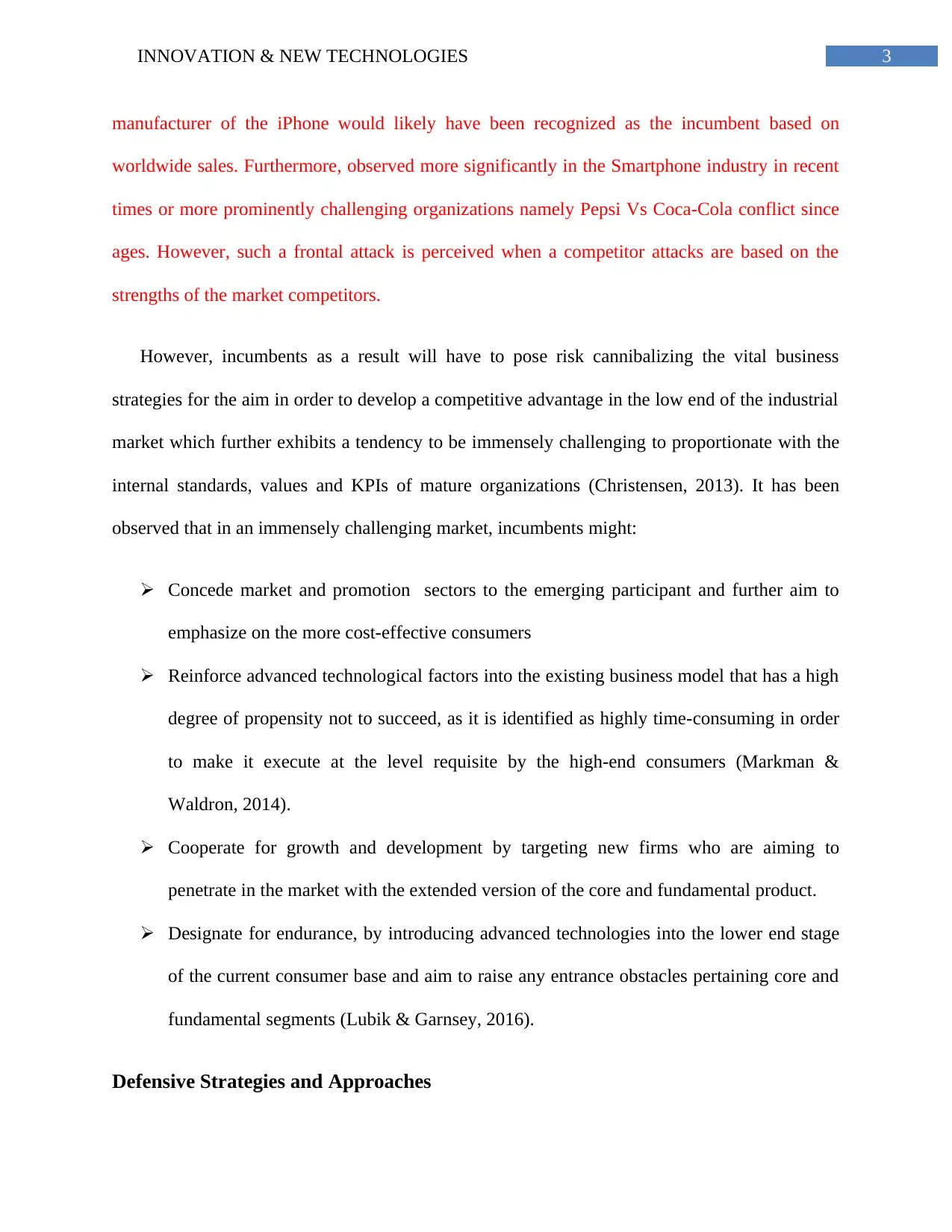
3INNOVATION & NEW TECHNOLOGIES
manufacturer of the iPhone would likely have been recognized as the incumbent based on
worldwide sales. Furthermore, observed more significantly in the Smartphone industry in recent
times or more prominently challenging organizations namely Pepsi Vs Coca-Cola conflict since
ages. However, such a frontal attack is perceived when a competitor attacks are based on the
strengths of the market competitors.
However, incumbents as a result will have to pose risk cannibalizing the vital business
strategies for the aim in order to develop a competitive advantage in the low end of the industrial
market which further exhibits a tendency to be immensely challenging to proportionate with the
internal standards, values and KPIs of mature organizations (Christensen, 2013). It has been
observed that in an immensely challenging market, incumbents might:
Concede market and promotion sectors to the emerging participant and further aim to
emphasize on the more cost-effective consumers
Reinforce advanced technological factors into the existing business model that has a high
degree of propensity not to succeed, as it is identified as highly time-consuming in order
to make it execute at the level requisite by the high-end consumers (Markman &
Waldron, 2014).
Cooperate for growth and development by targeting new firms who are aiming to
penetrate in the market with the extended version of the core and fundamental product.
Designate for endurance, by introducing advanced technologies into the lower end stage
of the current consumer base and aim to raise any entrance obstacles pertaining core and
fundamental segments (Lubik & Garnsey, 2016).
Defensive Strategies and Approaches
manufacturer of the iPhone would likely have been recognized as the incumbent based on
worldwide sales. Furthermore, observed more significantly in the Smartphone industry in recent
times or more prominently challenging organizations namely Pepsi Vs Coca-Cola conflict since
ages. However, such a frontal attack is perceived when a competitor attacks are based on the
strengths of the market competitors.
However, incumbents as a result will have to pose risk cannibalizing the vital business
strategies for the aim in order to develop a competitive advantage in the low end of the industrial
market which further exhibits a tendency to be immensely challenging to proportionate with the
internal standards, values and KPIs of mature organizations (Christensen, 2013). It has been
observed that in an immensely challenging market, incumbents might:
Concede market and promotion sectors to the emerging participant and further aim to
emphasize on the more cost-effective consumers
Reinforce advanced technological factors into the existing business model that has a high
degree of propensity not to succeed, as it is identified as highly time-consuming in order
to make it execute at the level requisite by the high-end consumers (Markman &
Waldron, 2014).
Cooperate for growth and development by targeting new firms who are aiming to
penetrate in the market with the extended version of the core and fundamental product.
Designate for endurance, by introducing advanced technologies into the lower end stage
of the current consumer base and aim to raise any entrance obstacles pertaining core and
fundamental segments (Lubik & Garnsey, 2016).
Defensive Strategies and Approaches
Paraphrase This Document
Need a fresh take? Get an instant paraphrase of this document with our AI Paraphraser
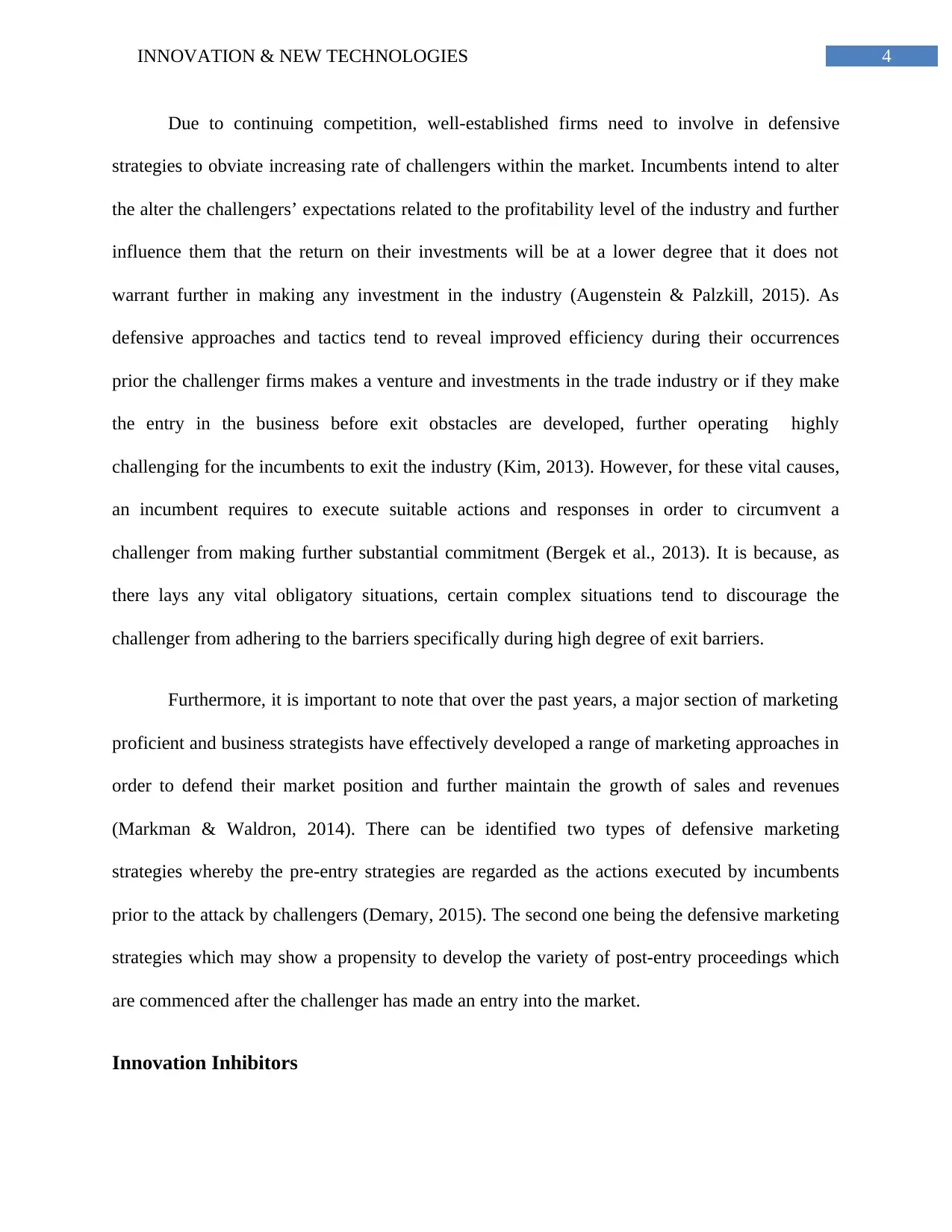
4INNOVATION & NEW TECHNOLOGIES
Due to continuing competition, well-established firms need to involve in defensive
strategies to obviate increasing rate of challengers within the market. Incumbents intend to alter
the alter the challengers’ expectations related to the profitability level of the industry and further
influence them that the return on their investments will be at a lower degree that it does not
warrant further in making any investment in the industry (Augenstein & Palzkill, 2015). As
defensive approaches and tactics tend to reveal improved efficiency during their occurrences
prior the challenger firms makes a venture and investments in the trade industry or if they make
the entry in the business before exit obstacles are developed, further operating highly
challenging for the incumbents to exit the industry (Kim, 2013). However, for these vital causes,
an incumbent requires to execute suitable actions and responses in order to circumvent a
challenger from making further substantial commitment (Bergek et al., 2013). It is because, as
there lays any vital obligatory situations, certain complex situations tend to discourage the
challenger from adhering to the barriers specifically during high degree of exit barriers.
Furthermore, it is important to note that over the past years, a major section of marketing
proficient and business strategists have effectively developed a range of marketing approaches in
order to defend their market position and further maintain the growth of sales and revenues
(Markman & Waldron, 2014). There can be identified two types of defensive marketing
strategies whereby the pre-entry strategies are regarded as the actions executed by incumbents
prior to the attack by challengers (Demary, 2015). The second one being the defensive marketing
strategies which may show a propensity to develop the variety of post-entry proceedings which
are commenced after the challenger has made an entry into the market.
Innovation Inhibitors
Due to continuing competition, well-established firms need to involve in defensive
strategies to obviate increasing rate of challengers within the market. Incumbents intend to alter
the alter the challengers’ expectations related to the profitability level of the industry and further
influence them that the return on their investments will be at a lower degree that it does not
warrant further in making any investment in the industry (Augenstein & Palzkill, 2015). As
defensive approaches and tactics tend to reveal improved efficiency during their occurrences
prior the challenger firms makes a venture and investments in the trade industry or if they make
the entry in the business before exit obstacles are developed, further operating highly
challenging for the incumbents to exit the industry (Kim, 2013). However, for these vital causes,
an incumbent requires to execute suitable actions and responses in order to circumvent a
challenger from making further substantial commitment (Bergek et al., 2013). It is because, as
there lays any vital obligatory situations, certain complex situations tend to discourage the
challenger from adhering to the barriers specifically during high degree of exit barriers.
Furthermore, it is important to note that over the past years, a major section of marketing
proficient and business strategists have effectively developed a range of marketing approaches in
order to defend their market position and further maintain the growth of sales and revenues
(Markman & Waldron, 2014). There can be identified two types of defensive marketing
strategies whereby the pre-entry strategies are regarded as the actions executed by incumbents
prior to the attack by challengers (Demary, 2015). The second one being the defensive marketing
strategies which may show a propensity to develop the variety of post-entry proceedings which
are commenced after the challenger has made an entry into the market.
Innovation Inhibitors
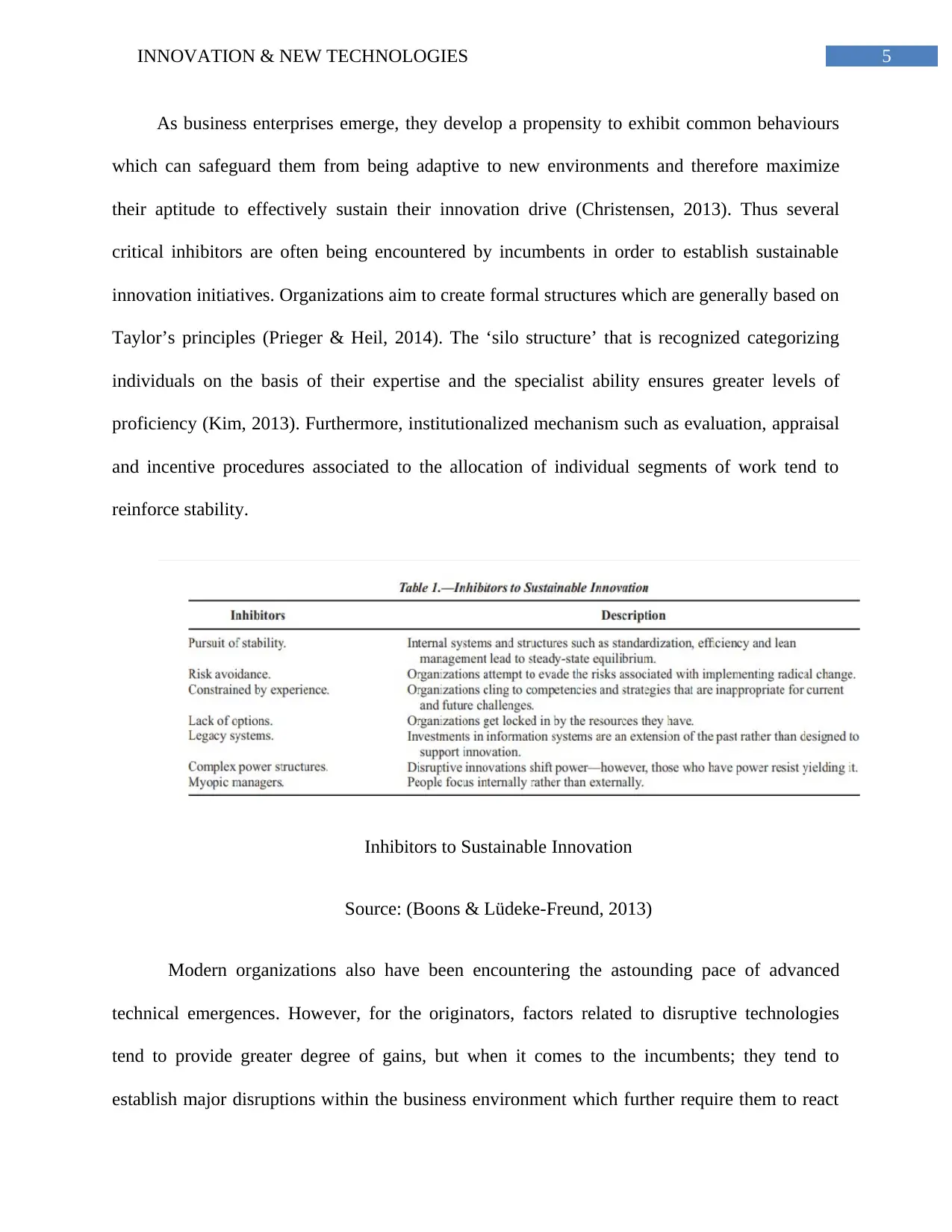
5INNOVATION & NEW TECHNOLOGIES
As business enterprises emerge, they develop a propensity to exhibit common behaviours
which can safeguard them from being adaptive to new environments and therefore maximize
their aptitude to effectively sustain their innovation drive (Christensen, 2013). Thus several
critical inhibitors are often being encountered by incumbents in order to establish sustainable
innovation initiatives. Organizations aim to create formal structures which are generally based on
Taylor’s principles (Prieger & Heil, 2014). The ‘silo structure’ that is recognized categorizing
individuals on the basis of their expertise and the specialist ability ensures greater levels of
proficiency (Kim, 2013). Furthermore, institutionalized mechanism such as evaluation, appraisal
and incentive procedures associated to the allocation of individual segments of work tend to
reinforce stability.
Inhibitors to Sustainable Innovation
Source: (Boons & Lüdeke-Freund, 2013)
Modern organizations also have been encountering the astounding pace of advanced
technical emergences. However, for the originators, factors related to disruptive technologies
tend to provide greater degree of gains, but when it comes to the incumbents; they tend to
establish major disruptions within the business environment which further require them to react
As business enterprises emerge, they develop a propensity to exhibit common behaviours
which can safeguard them from being adaptive to new environments and therefore maximize
their aptitude to effectively sustain their innovation drive (Christensen, 2013). Thus several
critical inhibitors are often being encountered by incumbents in order to establish sustainable
innovation initiatives. Organizations aim to create formal structures which are generally based on
Taylor’s principles (Prieger & Heil, 2014). The ‘silo structure’ that is recognized categorizing
individuals on the basis of their expertise and the specialist ability ensures greater levels of
proficiency (Kim, 2013). Furthermore, institutionalized mechanism such as evaluation, appraisal
and incentive procedures associated to the allocation of individual segments of work tend to
reinforce stability.
Inhibitors to Sustainable Innovation
Source: (Boons & Lüdeke-Freund, 2013)
Modern organizations also have been encountering the astounding pace of advanced
technical emergences. However, for the originators, factors related to disruptive technologies
tend to provide greater degree of gains, but when it comes to the incumbents; they tend to
establish major disruptions within the business environment which further require them to react
⊘ This is a preview!⊘
Do you want full access?
Subscribe today to unlock all pages.

Trusted by 1+ million students worldwide
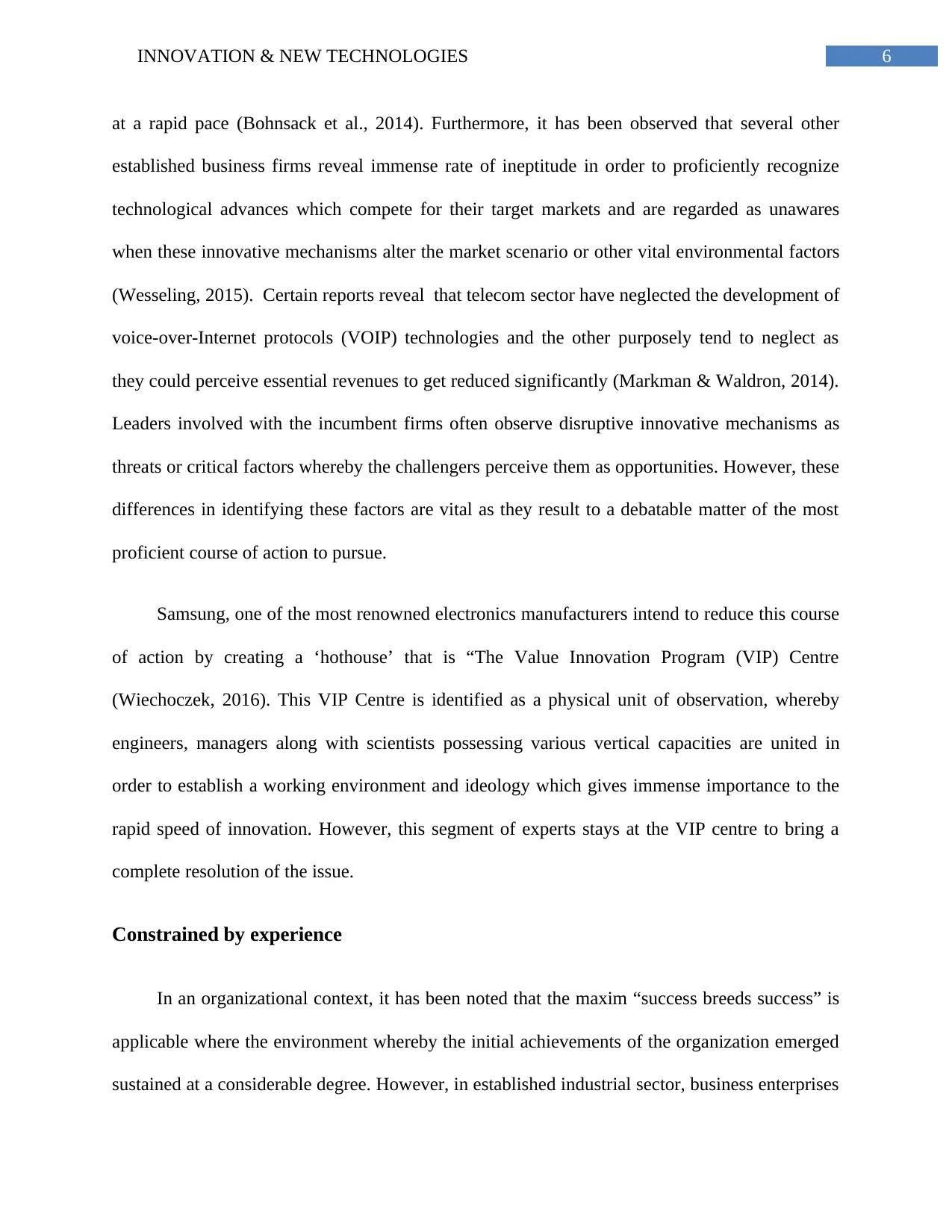
6INNOVATION & NEW TECHNOLOGIES
at a rapid pace (Bohnsack et al., 2014). Furthermore, it has been observed that several other
established business firms reveal immense rate of ineptitude in order to proficiently recognize
technological advances which compete for their target markets and are regarded as unawares
when these innovative mechanisms alter the market scenario or other vital environmental factors
(Wesseling, 2015). Certain reports reveal that telecom sector have neglected the development of
voice-over-Internet protocols (VOIP) technologies and the other purposely tend to neglect as
they could perceive essential revenues to get reduced significantly (Markman & Waldron, 2014).
Leaders involved with the incumbent firms often observe disruptive innovative mechanisms as
threats or critical factors whereby the challengers perceive them as opportunities. However, these
differences in identifying these factors are vital as they result to a debatable matter of the most
proficient course of action to pursue.
Samsung, one of the most renowned electronics manufacturers intend to reduce this course
of action by creating a ‘hothouse’ that is “The Value Innovation Program (VIP) Centre
(Wiechoczek, 2016). This VIP Centre is identified as a physical unit of observation, whereby
engineers, managers along with scientists possessing various vertical capacities are united in
order to establish a working environment and ideology which gives immense importance to the
rapid speed of innovation. However, this segment of experts stays at the VIP centre to bring a
complete resolution of the issue.
Constrained by experience
In an organizational context, it has been noted that the maxim “success breeds success” is
applicable where the environment whereby the initial achievements of the organization emerged
sustained at a considerable degree. However, in established industrial sector, business enterprises
at a rapid pace (Bohnsack et al., 2014). Furthermore, it has been observed that several other
established business firms reveal immense rate of ineptitude in order to proficiently recognize
technological advances which compete for their target markets and are regarded as unawares
when these innovative mechanisms alter the market scenario or other vital environmental factors
(Wesseling, 2015). Certain reports reveal that telecom sector have neglected the development of
voice-over-Internet protocols (VOIP) technologies and the other purposely tend to neglect as
they could perceive essential revenues to get reduced significantly (Markman & Waldron, 2014).
Leaders involved with the incumbent firms often observe disruptive innovative mechanisms as
threats or critical factors whereby the challengers perceive them as opportunities. However, these
differences in identifying these factors are vital as they result to a debatable matter of the most
proficient course of action to pursue.
Samsung, one of the most renowned electronics manufacturers intend to reduce this course
of action by creating a ‘hothouse’ that is “The Value Innovation Program (VIP) Centre
(Wiechoczek, 2016). This VIP Centre is identified as a physical unit of observation, whereby
engineers, managers along with scientists possessing various vertical capacities are united in
order to establish a working environment and ideology which gives immense importance to the
rapid speed of innovation. However, this segment of experts stays at the VIP centre to bring a
complete resolution of the issue.
Constrained by experience
In an organizational context, it has been noted that the maxim “success breeds success” is
applicable where the environment whereby the initial achievements of the organization emerged
sustained at a considerable degree. However, in established industrial sector, business enterprises
Paraphrase This Document
Need a fresh take? Get an instant paraphrase of this document with our AI Paraphraser
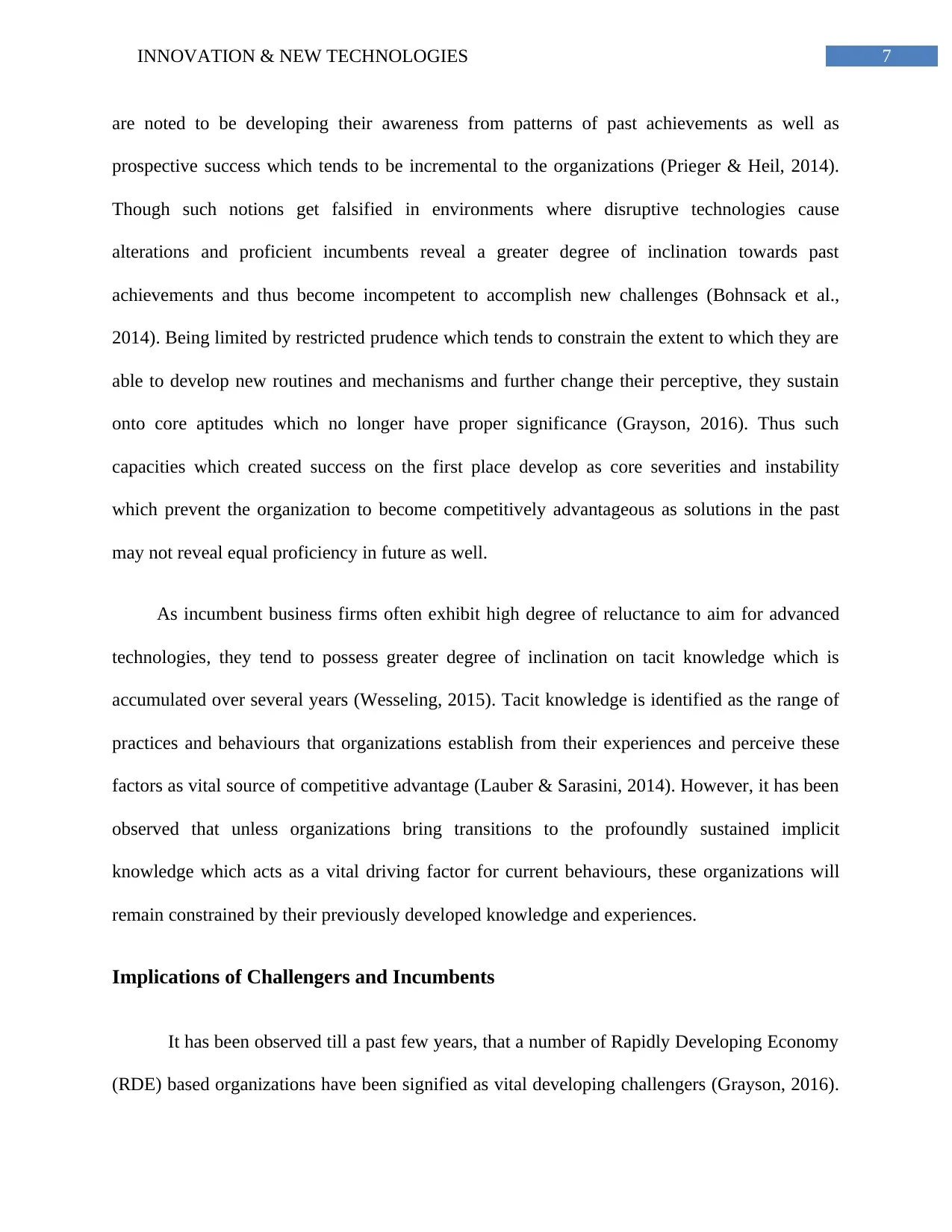
7INNOVATION & NEW TECHNOLOGIES
are noted to be developing their awareness from patterns of past achievements as well as
prospective success which tends to be incremental to the organizations (Prieger & Heil, 2014).
Though such notions get falsified in environments where disruptive technologies cause
alterations and proficient incumbents reveal a greater degree of inclination towards past
achievements and thus become incompetent to accomplish new challenges (Bohnsack et al.,
2014). Being limited by restricted prudence which tends to constrain the extent to which they are
able to develop new routines and mechanisms and further change their perceptive, they sustain
onto core aptitudes which no longer have proper significance (Grayson, 2016). Thus such
capacities which created success on the first place develop as core severities and instability
which prevent the organization to become competitively advantageous as solutions in the past
may not reveal equal proficiency in future as well.
As incumbent business firms often exhibit high degree of reluctance to aim for advanced
technologies, they tend to possess greater degree of inclination on tacit knowledge which is
accumulated over several years (Wesseling, 2015). Tacit knowledge is identified as the range of
practices and behaviours that organizations establish from their experiences and perceive these
factors as vital source of competitive advantage (Lauber & Sarasini, 2014). However, it has been
observed that unless organizations bring transitions to the profoundly sustained implicit
knowledge which acts as a vital driving factor for current behaviours, these organizations will
remain constrained by their previously developed knowledge and experiences.
Implications of Challengers and Incumbents
It has been observed till a past few years, that a number of Rapidly Developing Economy
(RDE) based organizations have been signified as vital developing challengers (Grayson, 2016).
are noted to be developing their awareness from patterns of past achievements as well as
prospective success which tends to be incremental to the organizations (Prieger & Heil, 2014).
Though such notions get falsified in environments where disruptive technologies cause
alterations and proficient incumbents reveal a greater degree of inclination towards past
achievements and thus become incompetent to accomplish new challenges (Bohnsack et al.,
2014). Being limited by restricted prudence which tends to constrain the extent to which they are
able to develop new routines and mechanisms and further change their perceptive, they sustain
onto core aptitudes which no longer have proper significance (Grayson, 2016). Thus such
capacities which created success on the first place develop as core severities and instability
which prevent the organization to become competitively advantageous as solutions in the past
may not reveal equal proficiency in future as well.
As incumbent business firms often exhibit high degree of reluctance to aim for advanced
technologies, they tend to possess greater degree of inclination on tacit knowledge which is
accumulated over several years (Wesseling, 2015). Tacit knowledge is identified as the range of
practices and behaviours that organizations establish from their experiences and perceive these
factors as vital source of competitive advantage (Lauber & Sarasini, 2014). However, it has been
observed that unless organizations bring transitions to the profoundly sustained implicit
knowledge which acts as a vital driving factor for current behaviours, these organizations will
remain constrained by their previously developed knowledge and experiences.
Implications of Challengers and Incumbents
It has been observed till a past few years, that a number of Rapidly Developing Economy
(RDE) based organizations have been signified as vital developing challengers (Grayson, 2016).
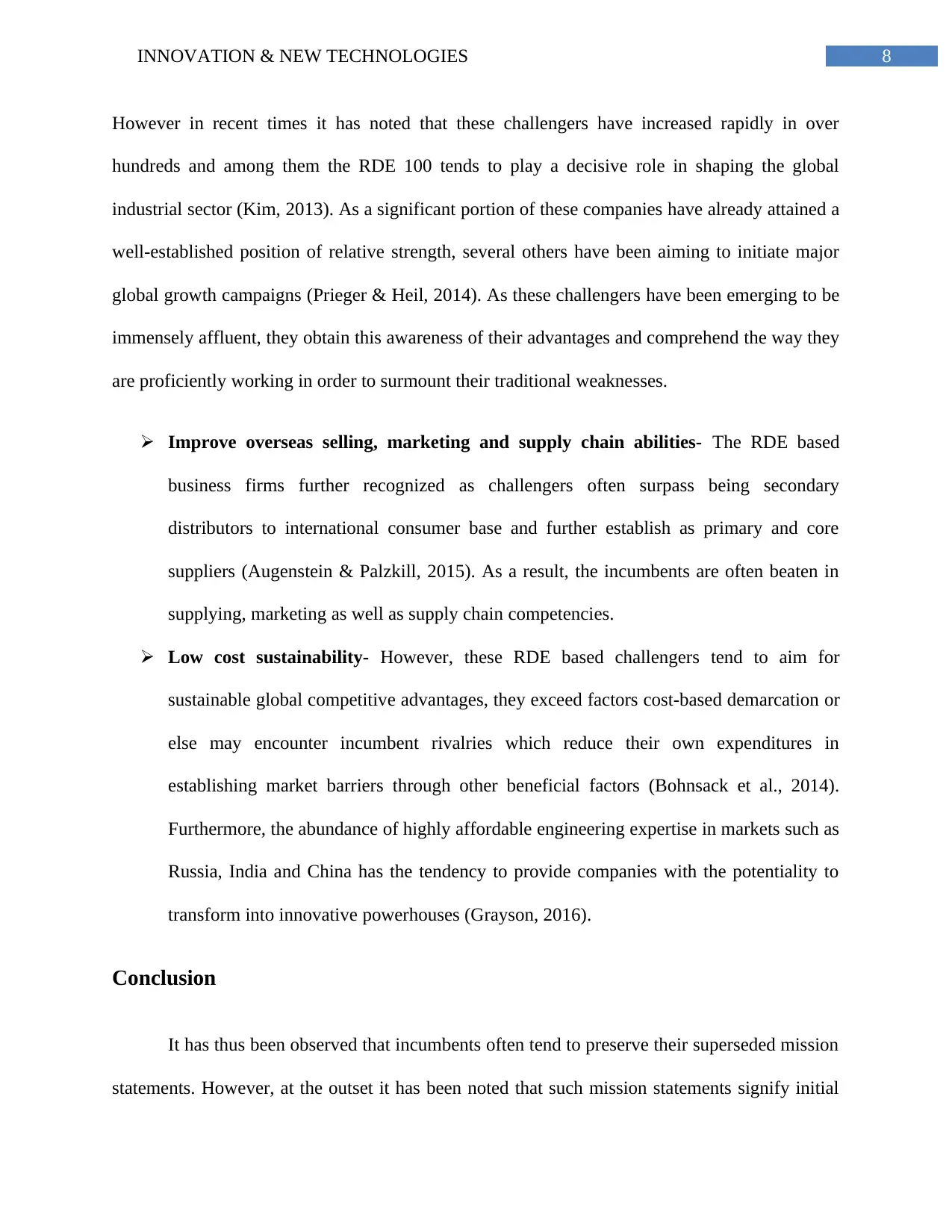
8INNOVATION & NEW TECHNOLOGIES
However in recent times it has noted that these challengers have increased rapidly in over
hundreds and among them the RDE 100 tends to play a decisive role in shaping the global
industrial sector (Kim, 2013). As a significant portion of these companies have already attained a
well-established position of relative strength, several others have been aiming to initiate major
global growth campaigns (Prieger & Heil, 2014). As these challengers have been emerging to be
immensely affluent, they obtain this awareness of their advantages and comprehend the way they
are proficiently working in order to surmount their traditional weaknesses.
Improve overseas selling, marketing and supply chain abilities- The RDE based
business firms further recognized as challengers often surpass being secondary
distributors to international consumer base and further establish as primary and core
suppliers (Augenstein & Palzkill, 2015). As a result, the incumbents are often beaten in
supplying, marketing as well as supply chain competencies.
Low cost sustainability- However, these RDE based challengers tend to aim for
sustainable global competitive advantages, they exceed factors cost-based demarcation or
else may encounter incumbent rivalries which reduce their own expenditures in
establishing market barriers through other beneficial factors (Bohnsack et al., 2014).
Furthermore, the abundance of highly affordable engineering expertise in markets such as
Russia, India and China has the tendency to provide companies with the potentiality to
transform into innovative powerhouses (Grayson, 2016).
Conclusion
It has thus been observed that incumbents often tend to preserve their superseded mission
statements. However, at the outset it has been noted that such mission statements signify initial
However in recent times it has noted that these challengers have increased rapidly in over
hundreds and among them the RDE 100 tends to play a decisive role in shaping the global
industrial sector (Kim, 2013). As a significant portion of these companies have already attained a
well-established position of relative strength, several others have been aiming to initiate major
global growth campaigns (Prieger & Heil, 2014). As these challengers have been emerging to be
immensely affluent, they obtain this awareness of their advantages and comprehend the way they
are proficiently working in order to surmount their traditional weaknesses.
Improve overseas selling, marketing and supply chain abilities- The RDE based
business firms further recognized as challengers often surpass being secondary
distributors to international consumer base and further establish as primary and core
suppliers (Augenstein & Palzkill, 2015). As a result, the incumbents are often beaten in
supplying, marketing as well as supply chain competencies.
Low cost sustainability- However, these RDE based challengers tend to aim for
sustainable global competitive advantages, they exceed factors cost-based demarcation or
else may encounter incumbent rivalries which reduce their own expenditures in
establishing market barriers through other beneficial factors (Bohnsack et al., 2014).
Furthermore, the abundance of highly affordable engineering expertise in markets such as
Russia, India and China has the tendency to provide companies with the potentiality to
transform into innovative powerhouses (Grayson, 2016).
Conclusion
It has thus been observed that incumbents often tend to preserve their superseded mission
statements. However, at the outset it has been noted that such mission statements signify initial
⊘ This is a preview!⊘
Do you want full access?
Subscribe today to unlock all pages.

Trusted by 1+ million students worldwide
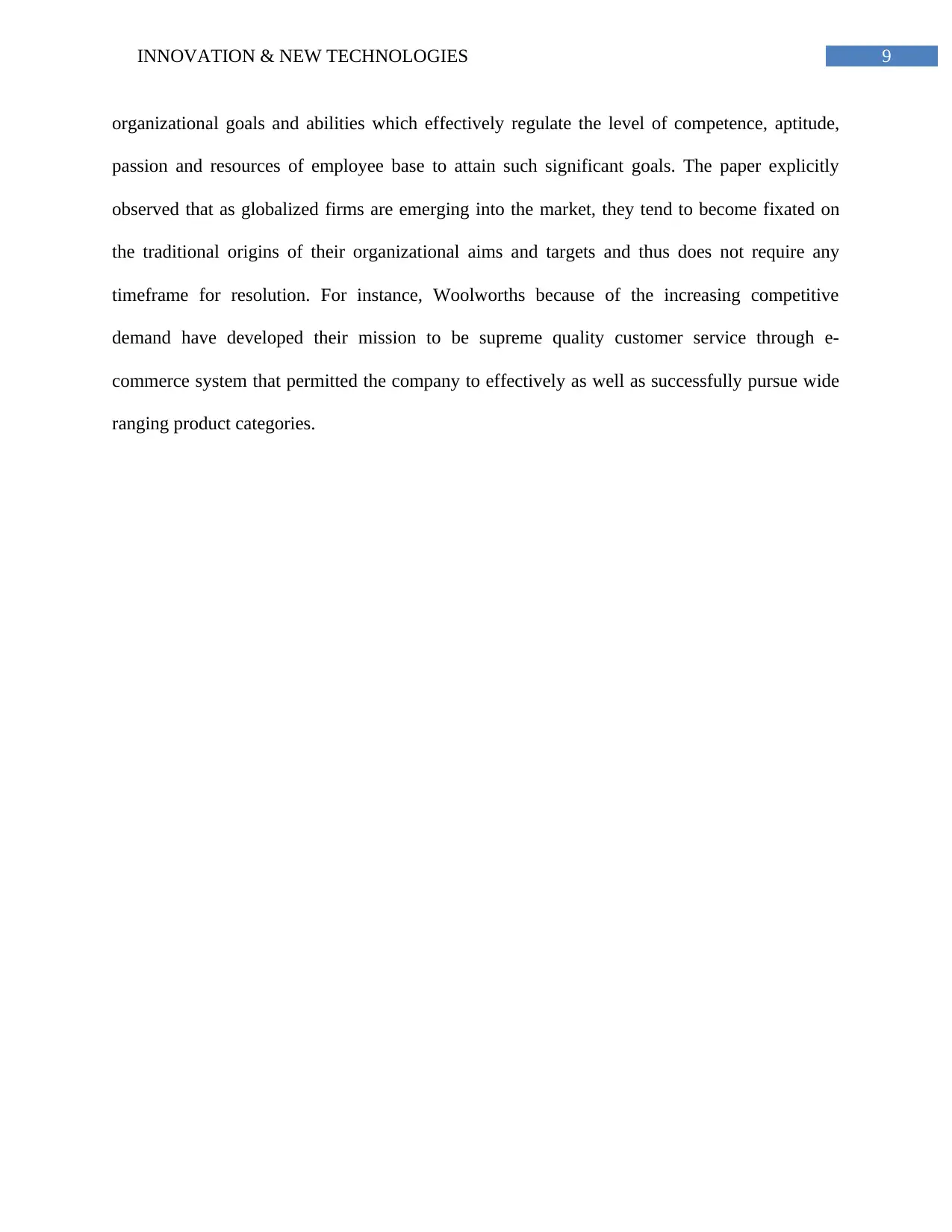
9INNOVATION & NEW TECHNOLOGIES
organizational goals and abilities which effectively regulate the level of competence, aptitude,
passion and resources of employee base to attain such significant goals. The paper explicitly
observed that as globalized firms are emerging into the market, they tend to become fixated on
the traditional origins of their organizational aims and targets and thus does not require any
timeframe for resolution. For instance, Woolworths because of the increasing competitive
demand have developed their mission to be supreme quality customer service through e-
commerce system that permitted the company to effectively as well as successfully pursue wide
ranging product categories.
organizational goals and abilities which effectively regulate the level of competence, aptitude,
passion and resources of employee base to attain such significant goals. The paper explicitly
observed that as globalized firms are emerging into the market, they tend to become fixated on
the traditional origins of their organizational aims and targets and thus does not require any
timeframe for resolution. For instance, Woolworths because of the increasing competitive
demand have developed their mission to be supreme quality customer service through e-
commerce system that permitted the company to effectively as well as successfully pursue wide
ranging product categories.
Paraphrase This Document
Need a fresh take? Get an instant paraphrase of this document with our AI Paraphraser
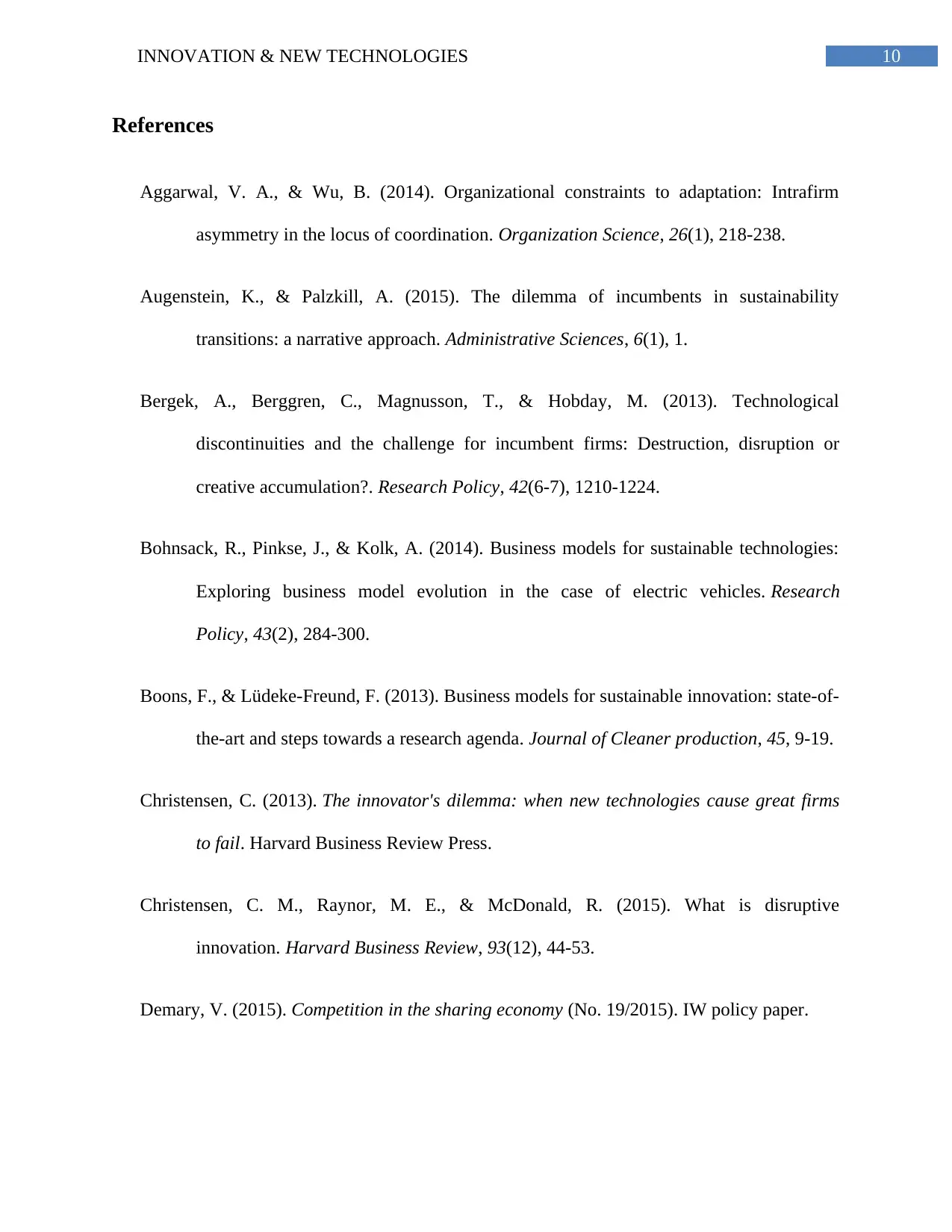
10INNOVATION & NEW TECHNOLOGIES
References
Aggarwal, V. A., & Wu, B. (2014). Organizational constraints to adaptation: Intrafirm
asymmetry in the locus of coordination. Organization Science, 26(1), 218-238.
Augenstein, K., & Palzkill, A. (2015). The dilemma of incumbents in sustainability
transitions: a narrative approach. Administrative Sciences, 6(1), 1.
Bergek, A., Berggren, C., Magnusson, T., & Hobday, M. (2013). Technological
discontinuities and the challenge for incumbent firms: Destruction, disruption or
creative accumulation?. Research Policy, 42(6-7), 1210-1224.
Bohnsack, R., Pinkse, J., & Kolk, A. (2014). Business models for sustainable technologies:
Exploring business model evolution in the case of electric vehicles. Research
Policy, 43(2), 284-300.
Boons, F., & Lüdeke-Freund, F. (2013). Business models for sustainable innovation: state-of-
the-art and steps towards a research agenda. Journal of Cleaner production, 45, 9-19.
Christensen, C. (2013). The innovator's dilemma: when new technologies cause great firms
to fail. Harvard Business Review Press.
Christensen, C. M., Raynor, M. E., & McDonald, R. (2015). What is disruptive
innovation. Harvard Business Review, 93(12), 44-53.
Demary, V. (2015). Competition in the sharing economy (No. 19/2015). IW policy paper.
References
Aggarwal, V. A., & Wu, B. (2014). Organizational constraints to adaptation: Intrafirm
asymmetry in the locus of coordination. Organization Science, 26(1), 218-238.
Augenstein, K., & Palzkill, A. (2015). The dilemma of incumbents in sustainability
transitions: a narrative approach. Administrative Sciences, 6(1), 1.
Bergek, A., Berggren, C., Magnusson, T., & Hobday, M. (2013). Technological
discontinuities and the challenge for incumbent firms: Destruction, disruption or
creative accumulation?. Research Policy, 42(6-7), 1210-1224.
Bohnsack, R., Pinkse, J., & Kolk, A. (2014). Business models for sustainable technologies:
Exploring business model evolution in the case of electric vehicles. Research
Policy, 43(2), 284-300.
Boons, F., & Lüdeke-Freund, F. (2013). Business models for sustainable innovation: state-of-
the-art and steps towards a research agenda. Journal of Cleaner production, 45, 9-19.
Christensen, C. (2013). The innovator's dilemma: when new technologies cause great firms
to fail. Harvard Business Review Press.
Christensen, C. M., Raynor, M. E., & McDonald, R. (2015). What is disruptive
innovation. Harvard Business Review, 93(12), 44-53.
Demary, V. (2015). Competition in the sharing economy (No. 19/2015). IW policy paper.
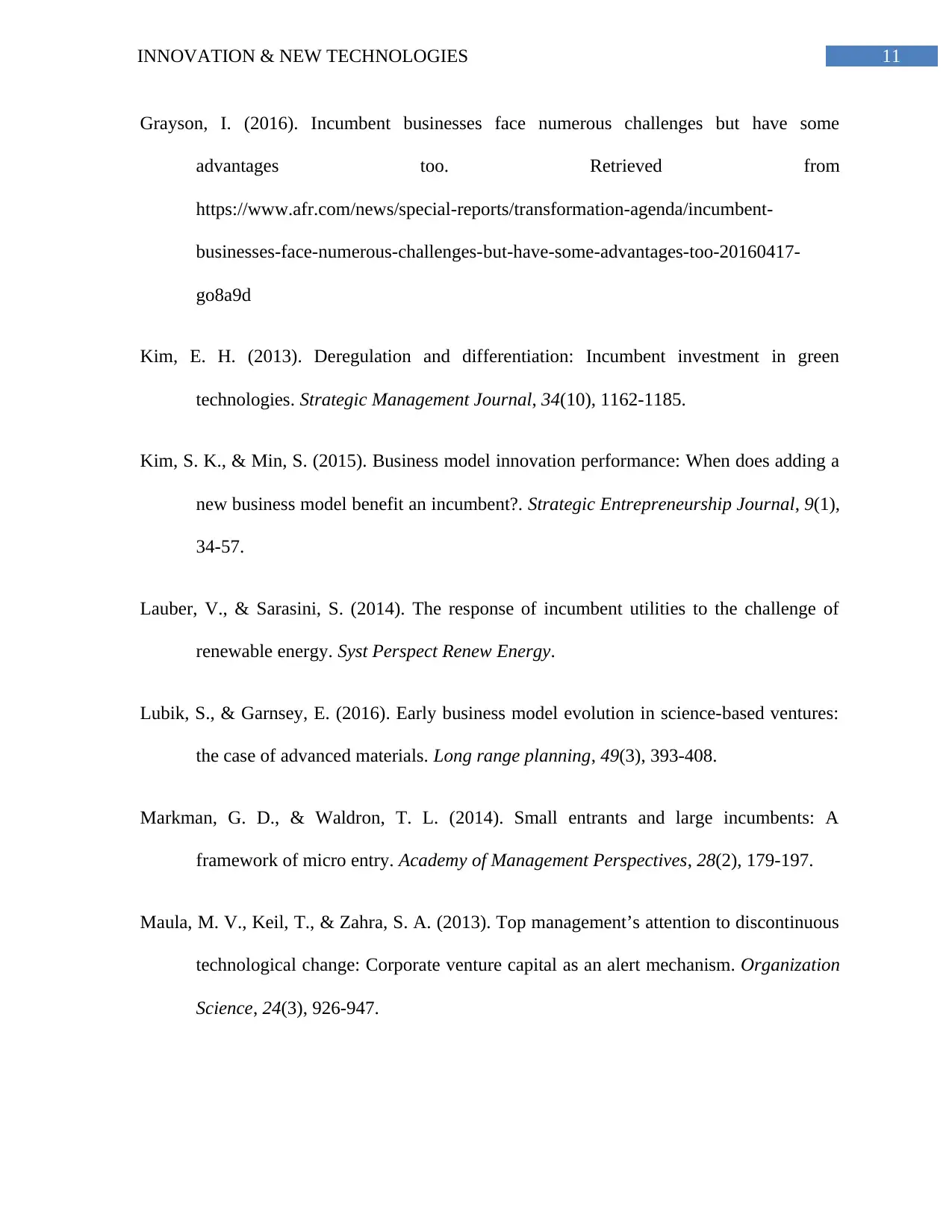
11INNOVATION & NEW TECHNOLOGIES
Grayson, I. (2016). Incumbent businesses face numerous challenges but have some
advantages too. Retrieved from
https://www.afr.com/news/special-reports/transformation-agenda/incumbent-
businesses-face-numerous-challenges-but-have-some-advantages-too-20160417-
go8a9d
Kim, E. H. (2013). Deregulation and differentiation: Incumbent investment in green
technologies. Strategic Management Journal, 34(10), 1162-1185.
Kim, S. K., & Min, S. (2015). Business model innovation performance: When does adding a
new business model benefit an incumbent?. Strategic Entrepreneurship Journal, 9(1),
34-57.
Lauber, V., & Sarasini, S. (2014). The response of incumbent utilities to the challenge of
renewable energy. Syst Perspect Renew Energy.
Lubik, S., & Garnsey, E. (2016). Early business model evolution in science-based ventures:
the case of advanced materials. Long range planning, 49(3), 393-408.
Markman, G. D., & Waldron, T. L. (2014). Small entrants and large incumbents: A
framework of micro entry. Academy of Management Perspectives, 28(2), 179-197.
Maula, M. V., Keil, T., & Zahra, S. A. (2013). Top management’s attention to discontinuous
technological change: Corporate venture capital as an alert mechanism. Organization
Science, 24(3), 926-947.
Grayson, I. (2016). Incumbent businesses face numerous challenges but have some
advantages too. Retrieved from
https://www.afr.com/news/special-reports/transformation-agenda/incumbent-
businesses-face-numerous-challenges-but-have-some-advantages-too-20160417-
go8a9d
Kim, E. H. (2013). Deregulation and differentiation: Incumbent investment in green
technologies. Strategic Management Journal, 34(10), 1162-1185.
Kim, S. K., & Min, S. (2015). Business model innovation performance: When does adding a
new business model benefit an incumbent?. Strategic Entrepreneurship Journal, 9(1),
34-57.
Lauber, V., & Sarasini, S. (2014). The response of incumbent utilities to the challenge of
renewable energy. Syst Perspect Renew Energy.
Lubik, S., & Garnsey, E. (2016). Early business model evolution in science-based ventures:
the case of advanced materials. Long range planning, 49(3), 393-408.
Markman, G. D., & Waldron, T. L. (2014). Small entrants and large incumbents: A
framework of micro entry. Academy of Management Perspectives, 28(2), 179-197.
Maula, M. V., Keil, T., & Zahra, S. A. (2013). Top management’s attention to discontinuous
technological change: Corporate venture capital as an alert mechanism. Organization
Science, 24(3), 926-947.
⊘ This is a preview!⊘
Do you want full access?
Subscribe today to unlock all pages.

Trusted by 1+ million students worldwide
1 out of 13
Related Documents
Your All-in-One AI-Powered Toolkit for Academic Success.
+13062052269
info@desklib.com
Available 24*7 on WhatsApp / Email
![[object Object]](/_next/static/media/star-bottom.7253800d.svg)
Unlock your academic potential
Copyright © 2020–2025 A2Z Services. All Rights Reserved. Developed and managed by ZUCOL.





